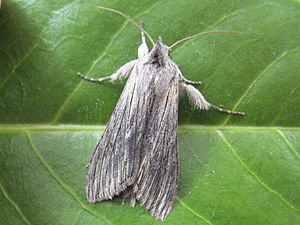Chamomile monk
| Chamomile monk | ||||||||||||
|---|---|---|---|---|---|---|---|---|---|---|---|---|

Chamomile monk ( Cucullia chamomillae ) |
||||||||||||
| Systematics | ||||||||||||
|
||||||||||||
| Scientific name | ||||||||||||
| Cucullia chamomillae | ||||||||||||
| ( Denis & Schiffermüller , 1775) |
The chamomile monk ( Cucullia chamomillae ), sometimes also called the chamomile gray monk , is a butterfly ( moth ) from the family of the owl butterflies (Noctuidae). The specific epithet refers to the chamomile ( Matricaria chamomilla ), a food plant of the caterpillars.
features
butterfly
The moths reach a wingspan of 41 to 50 millimeters. The front edge of the gray to brown-gray colored fore wings is dark brown, white at the root. Blemishes are indistinct or not recognizable. The veins lead as thin black lines to the hem. The hind wings are brownish-gray in color and slightly lightened at the base. On the head there is a pointed head of gray to gray-brown hair pointing forward. The proboscis is well developed.
egg
The egg is conical, truncated at the top and covered with many ribs. It is white in color, against which small reddish brown spots stand out.
Caterpillar
Adult caterpillars occur in different colored morphs. They show broad slashes on the back in the form of a slightly opened V and clear arched lines on the sides. The basic color varies from whitish, cream-colored, greenish, light brown, red-brown or purple to blackish. The stigmas are bordered in white and black. The head is spotted dark.
Doll
The doll is yellowish brown in color. The trunk sheath stands out clearly. The cremaster is flat, slightly curved and spatulate.
Similar species
- The shadow monk ( Cucullia umbratica ) differs by the ash-gray color of the forewing upper side as well as the lighter hind wings and the very pointed apex .
- Cucullia calendulae is distinguished by a slightly ocher-colored over-dusting on the upper side of the forewing as well as a ring flaw indicated by black dots.
- Cucullia santolinae is distinguished by a slightly bluish over-dusting on the upper side of the forewing as well as a flawed kidney indicated as a weak dark arch.
- With a wingspan of 29 to 40 millimeters, Cucullia inderiensis is always smaller than Cucullia chamomillae .
distribution and habitat
The species occurs north to northern England , Denmark , southern Sweden and Latvia , south to Morocco , Algeria and Tunisia as well as Malta and Crete . Specimens from Asia Minor belong to the subspecies Cucullia chamomilla hackeri . The eastern distribution extends to the Urals and Caucasus as well as to Tajikistan . The chamomile monk is mainly found in sunny hill areas, on warm slopes, in sand pits, quarries, on the edge of gravel pits, in grain fields and wastelands as well as in gardens and parklands. The species prefers sandy soil.
Way of life
The species usually forms one generation per year, the moths of which fly from March to June. In rare cases, a second generation appears in September. The moths are crepuscular and nocturnal, but rarely visit artificial light sources . During the day, they like to rest on walls or tree trunks. The eggs are laid individually on the leaves of a food plant. The caterpillars feed mainly on the leaves and flowers of various chamomiles - ( Matricaria ) and dog chamomile species ( Anthemis ). They live between June and August. In late summer they pupate in the ground in a firm cocoon, where the pupae overwinter and often lie over.
Danger
The chamomile monk occurs in Germany in different numbers in the individual federal states and is classified on the red list of endangered species "on the warning list". However, the species reacts very quickly to ecological niches created by humans through construction activity or abandonment of use (fallow land) .
Individual evidence
- ^ Arnold Spuler: The butterflies of Europe. Volume 1 E. Schweitzerbartsche Verlagbuchhandlung, Stuttgart 1908, p. 273
- ↑ a b c Gábor Ronkay & László Ronkay: Cucullinae I . In: Michael Fibiger, Martin R. Honey, W. Gerald Tremevan (Eds.): Noctuidae Europaeae . tape 6 . Entomological Press, Sorø 1994, ISBN 87-89430-03-4 (English). , P. 91/92
- ^ A b Walter Forster , Theodor A. Wohlfahrt : The butterflies of Central Europe. Volume 4: Owls. (Noctuidae). Franckh'sche Verlagshandlung, Stuttgart 1971, ISBN 3-440-03752-5 , pp. 173-174.
- ↑ a b c d e Günter Ebert (Ed.): The butterflies of Baden-Württemberg . 1st edition. tape 6 . Moth IV. Noctuidae 2nd part. Ulmer, Stuttgart (Hohenheim) 1997, ISBN 3-8001-3482-9 . , Pp. 184-188
- ↑ Markku Savela: Tanaecia Butler (1869) - distribution. In: Lepidoptera and some other life forms. Retrieved September 18, 2018 .
- ↑ Manfred Koch : We identify butterflies. Volume 3: Owls. 2nd, expanded edition. Neumann, Leipzig / Radebeul 1972, DNB 760072930 , pp. 118-119.
- ↑ Endangerment
literature
- Günter Ebert (Ed.): The butterflies of Baden-Württemberg . 1st edition. tape 6 . Moth IV. Noctuidae 2nd part. Ulmer, Stuttgart (Hohenheim) 1997, ISBN 3-8001-3482-9 .
- Gábor Ronkay & László Ronkay: Cucullinae I . In: Michael Fibiger, Martin R. Honey, W. Gerald Tremevan (Eds.): Noctuidae Europaeae . tape 6 . Entomological Press, Sorø 1994, ISBN 87-89430-03-4 (English).
Web links
- Lepiforum e. V. - Taxonomy and photos
- www.pyrgus.de - Butterflies and their ecology
- www.leps.it - Moths and Butterflies of Europe and North Africa
- Cucullia chamomillae at Fauna Europaea. Retrieved September 19, 2018

